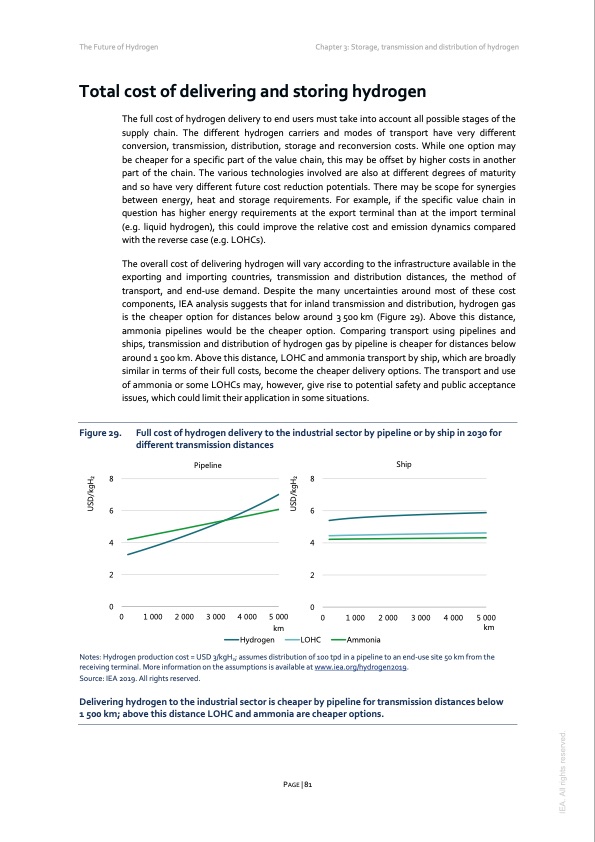
PDF Publication Title:
Text from PDF Page: 081
The Future of Hydrogen Chapter 3: Storage, transmission and distribution of hydrogen Total cost of delivering and storing hydrogen The full cost of hydrogen delivery to end users must take into account all possible stages of the supply chain. The different hydrogen carriers and modes of transport have very different conversion, transmission, distribution, storage and reconversion costs. While one option may be cheaper for a specific part of the value chain, this may be offset by higher costs in another part of the chain. The various technologies involved are also at different degrees of maturity and so have very different future cost reduction potentials. There may be scope for synergies between energy, heat and storage requirements. For example, if the specific value chain in question has higher energy requirements at the export terminal than at the import terminal (e.g. liquid hydrogen), this could improve the relative cost and emission dynamics compared with the reverse case (e.g. LOHCs). The overall cost of delivering hydrogen will vary according to the infrastructure available in the exporting and importing countries, transmission and distribution distances, the method of transport, and end-use demand. Despite the many uncertainties around most of these cost components, IEA analysis suggests that for inland transmission and distribution, hydrogen gas is the cheaper option for distances below around 3 500 km (Figure 29). Above this distance, ammonia pipelines would be the cheaper option. Comparing transport using pipelines and ships, transmission and distribution of hydrogen gas by pipeline is cheaper for distances below around 1 500 km. Above this distance, LOHC and ammonia transport by ship, which are broadly similar in terms of their full costs, become the cheaper delivery options. The transport and use of ammonia or some LOHCs may, however, give rise to potential safety and public acceptance issues, which could limit their application in some situations. Figure 29. Full cost of hydrogen delivery to the industrial sector by pipeline or by ship in 2030 for different transmission distances Pipeline 88 66 44 22 00 0 1 000 2 000 3 000 4 000 5 000 0 km Hydrogen LOHC Ship Notes: Hydrogen production cost = USD 3/kgH2; assumes distribution of 100 tpd in a pipeline to an end-use site 50 km from the receiving terminal. More information on the assumptions is available at www.iea.org/hydrogen2019. Source: IEA 2019. All rights reserved. Delivering hydrogen to the industrial sector is cheaper by pipeline for transmission distances below 1 500 km; above this distance LOHC and ammonia are cheaper options. 1 000 2 000 3 000 4 000 5 000 km Ammonia PAGE | 81 IEA. All rights reserved. USD/kgH2 USD/kgH2PDF Image | The Future of Hydrogen 2019

PDF Search Title:
The Future of Hydrogen 2019Original File Name Searched:
the_future_of_hydrogen.pdfDIY PDF Search: Google It | Yahoo | Bing
NFT (Non Fungible Token): Buy our tech, design, development or system NFT and become part of our tech NFT network... More Info
IT XR Project Redstone NFT Available for Sale: NFT for high tech turbine design with one part 3D printed counter-rotating energy turbine. Be part of the future with this NFT. Can be bought and sold but only one design NFT exists. Royalties go to the developer (Infinity) to keep enhancing design and applications... More Info
Infinity Turbine IT XR Project Redstone Design: NFT for sale... NFT for high tech turbine design with one part 3D printed counter-rotating energy turbine. Includes all rights to this turbine design, including license for Fluid Handling Block I and II for the turbine assembly and housing. The NFT includes the blueprints (cad/cam), revenue streams, and all future development of the IT XR Project Redstone... More Info
Infinity Turbine ROT Radial Outflow Turbine 24 Design and Worldwide Rights: NFT for sale... NFT for the ROT 24 energy turbine. Be part of the future with this NFT. This design can be bought and sold but only one design NFT exists. You may manufacture the unit, or get the revenues from its sale from Infinity Turbine. Royalties go to the developer (Infinity) to keep enhancing design and applications... More Info
Infinity Supercritical CO2 10 Liter Extractor Design and Worldwide Rights: The Infinity Supercritical 10L CO2 extractor is for botanical oil extraction, which is rich in terpenes and can produce shelf ready full spectrum oil. With over 5 years of development, this industry leader mature extractor machine has been sold since 2015 and is part of many profitable businesses. The process can also be used for electrowinning, e-waste recycling, and lithium battery recycling, gold mining electronic wastes, precious metals. CO2 can also be used in a reverse fuel cell with nafion to make a gas-to-liquids fuel, such as methanol, ethanol and butanol or ethylene. Supercritical CO2 has also been used for treating nafion to make it more effective catalyst. This NFT is for the purchase of worldwide rights which includes the design. More Info
NFT (Non Fungible Token): Buy our tech, design, development or system NFT and become part of our tech NFT network... More Info
Infinity Turbine Products: Special for this month, any plans are $10,000 for complete Cad/Cam blueprints. License is for one build. Try before you buy a production license. May pay by Bitcoin or other Crypto. Products Page... More Info
| CONTACT TEL: 608-238-6001 Email: greg@infinityturbine.com | RSS | AMP |